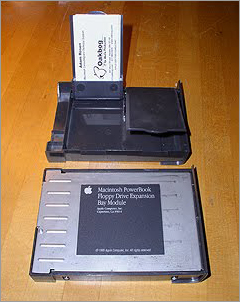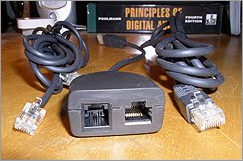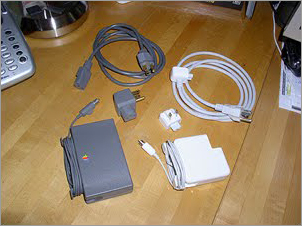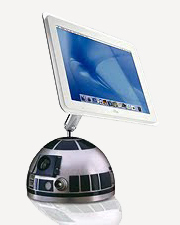PowerBook Esoterica
 Greetings and Happy Holidaze from Boston! A few recent donations to the Mac Museum got me musing about unusual bits of PowerBook Esoterica, and how good ideas are often repeated but skip product generations.
Greetings and Happy Holidaze from Boston! A few recent donations to the Mac Museum got me musing about unusual bits of PowerBook Esoterica, and how good ideas are often repeated but skip product generations.
A colleague of mine recently donated a PowerBook 3400c and assorted box of Mac items to me, which I was happy to give a good home. The 3400c was the top of the line PowerBook in the pre-G3 era, and vendors really took advantage of it’s ability to add capability via expansion bays. A CD-ROM drive, spare batteries, floppy drive and Zip drive modules were common on this series, and the expansion bay design survived across the G3 Wallstreet, Lombard and Pismo models.
However one thing I’d never seen before was this unique module, which mimics the floppy disk module but is (apparently) meant to store business cards or other similarly sized items in your laptop! The donator didn’t know the history of this computer, so we don’t know who made this acccessory or how popular it was. Definitely a better use of space than the PowerBook G3 (Pismo) Weight Saving device – essentially a hollow battery case that nobody ever used – but I still would have used a Zip module myself.
 The 3400c wasn’t done with it’s surprises yet. Among the pile of cables in the box was a combination RJ45 ethernet jack and RJ11 phone jack, which used an RJ45 jack to connect to the computer. While ethernet ports and modems are both communications devices, it’s rare to see them combined in this fashion. It saves about a half inch of space on the back of the laptop but instead creates a new, custom adapter. Sometimes the way Apple thinks is, well, Just Different. But I do appreciate the matching dark grey ethernet and phone cables which were included – a classy touch!
The 3400c wasn’t done with it’s surprises yet. Among the pile of cables in the box was a combination RJ45 ethernet jack and RJ11 phone jack, which used an RJ45 jack to connect to the computer. While ethernet ports and modems are both communications devices, it’s rare to see them combined in this fashion. It saves about a half inch of space on the back of the laptop but instead creates a new, custom adapter. Sometimes the way Apple thinks is, well, Just Different. But I do appreciate the matching dark grey ethernet and phone cables which were included – a classy touch!
A few weeks later the Museum was given a PowerBook Duo 230c along with a box containing the dock and many accessories. The Duo was Apple’s first sub-notebook sized computer, similar to the 2400c and 12″ iBook/PowerBook G4. The computer just has the CPU, keyboard and screen, and used a dock (full or mini) to connect to monitors and other peripherals. The Duo hit a niche for many PowerBook users and was a popular model during the 68k and PowerPC eras. I’ve always preferred fully functional integrated laptops for my own use, so I wasn’t very familiar with this series.
 Besides the elegant engineering of the dock itself, what really caught my attention was the design of the AC adapter. The transformer (power brick) has an AC port which can be used interchangeably with a long AC cord or a short AC plug to vary the overall length; it also contained a pair of fold out flaps around which to wind the thin DC power cord which plugged directly into the computer. Look familiar? Other than the color difference and some small design changes, it’s not much different than the AC adapter introduced with the iBook/PowerBook G4 and used to this day!
Besides the elegant engineering of the dock itself, what really caught my attention was the design of the AC adapter. The transformer (power brick) has an AC port which can be used interchangeably with a long AC cord or a short AC plug to vary the overall length; it also contained a pair of fold out flaps around which to wind the thin DC power cord which plugged directly into the computer. Look familiar? Other than the color difference and some small design changes, it’s not much different than the AC adapter introduced with the iBook/PowerBook G4 and used to this day!
Plus ça change, plus c’est la même chose.
A warm thanks to Andy Espo of Natick, MA for the PowerBook 3400c, and to John Chapin of Cambridge, MA for the PowerBook Duo 230c. Your generosity is appreciated.
The Cult of Mac bows to you, and sacrifices a new PC running Windows 7 in your honor…


ORIGINAL BLOGSPOT COMMENTS:
Stephen said…
I think you’ll actually find that the ethernet/modem port isn’t a custom port. An RJ11 telephone cable will plug into the RJ45 socket, where all it needs are the middle two pins. An RJ45 will also plug in, but 10base-T (did this have 100?) doesn’t actually use the middle two pins, it was only at gigabit that ethernet uses all four pairs. The result is a single socket that can be used for modem or network, but not both at the same time. It looks like that adapter is to allow you to overcome that limitation.
December 28, 2009 at 5:17 AM
Adam Rosen said…
Good point, yes, that would explain what it’s for. What I still don’t understand is why Apple would go to the expense of creating and manufacturing the adapter, as opposed to just fitting an RJ11 jack on the back of the computer!
December 28, 2009 at 7:47 AM
Anonymous said…
The “empty” 3400 drive bay module was actually made by Apple and included with the 3400; it’s officially known as the Weight-Saving Expansion Bay Module. I seem to recall that the slots inside it were intended to hold PCMCIA cards, but obviously you can stick business cards in there too.
January 13, 2010 at 9:17 AM